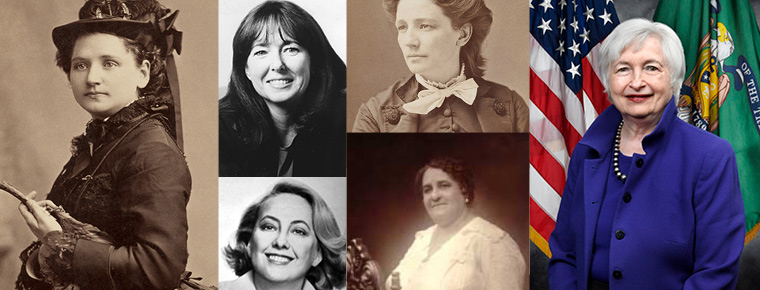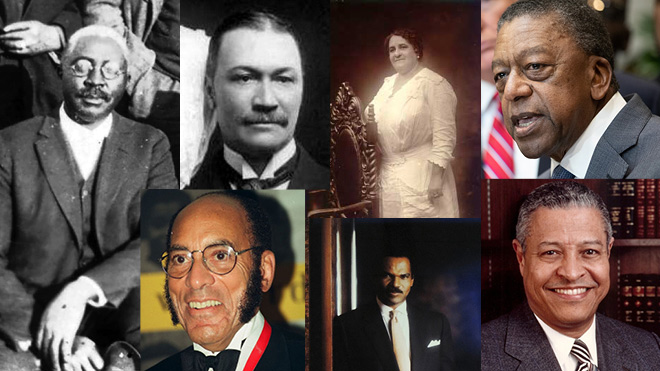
10 Women Finance Leaders in History
Celebrate 10 women who broke the glass ceiling in the financial industry, advancing equity for women and reshaping history.
It's only been 50 years since the Equal Credit Opportunity Act was passed in 1974, giving women the right to get cards in their own name. Fast forward to today, the financial lives of women have advanced significantly — but disparities still exist between women and men.
In 2022, results of a U.S. Bureau of Labor Statistics survey showed that median earnings for women were 83% of men's. And the wage gap doesn't stop there, white women make 82 cents for every dollar a white man makes, while the amount for Black and Hispanic women is 70 cents and 65 cents, respectively, of what men make, according to a Pew Research report.
Many women throughout history and around the globe have worked, lobbied and protested to further women's financial rights and access to financial equity.
The following financial leaders are a reminder of the work already done and the work we can all continue to do as we strive for gender equity.
Louise M. Weiser (1837-1898)
Louise Weiser is the first woman named president of an American bank, succeeding her husband, Horace Spangler Weiser, who served as president for Winneshiek County Bank in Decorah, Iowa. Weiser assumed the role shortly after her husband's death in 1875 until 1892 when her son, C.S. Weiser, became the bank's third president.
Victoria Woodhull (1838-1927) and Tennessee Claflin
(1846-1923)
Victoria Woodhull advocated for social and labor causes, including the eight-hour workday and progressive income taxes. She also worked alongside her sister, suffragist Tennessee Claflin, to establish the first woman-owned stock brokerage, Woodhull, Claflin and Co., in 1870. In 1868, the sisters moved to Manhattan and connected with railroad magnate Cornelius Vanderbilt. The sisters opened their brokerage with Vanderbilt's behind-the-scenes financial support. Victoria said she went to Wall Street not out of interest in becoming a stock broker, but to "plant the flag of women's rebellion" in North America, according to the Museum of the City of New York's blog.
Maggie Lena Walker (1864-1934)
Maggie Lena Walker, born the daughter of an enslaved couple in Richmond, Virginia, became a prominent entrepreneur and the first woman bank owner in the U.S. Walker faced dual challenges of being a woman and being Black when she established the St. Luke Penny Savings Bank in 1903. The institution had grown significantly by 1924 and, after mergers with two other banks, survived the Great Depression. Walker's house in Richmond has since been designated a National Historic Site by the National Park Service.
Dora Maxwell (1897-1985)
An attendee of the historic 1934 Estes Park Conference that founded CUNA, Dora Maxwell organized hundreds of credit unions. Her work was primarily for oil and gas industry employees and additional trade associations, giving them access to advantageous financial options where banks were repeatedly failing them. After her years of service, CUNA established an award in her name called the "Dora Maxwell Social Responsibility Community Service Award." It is awarded annually to credit union chapters or groups for social responsibility projects within the community.
Louise Herring (1909-1987)
Louise Herring, sometimes called "the mother of credit unions," was only 23 years old when she started to organize credit unions. An employee of the Kroger Company, Herring set up credit unions to serve Kroger employees, who often had difficulty getting loans from banks. Herring became involved with the national cooperative movement and was a key player at the 1934 Estes Park conference that established the Credit Union National Association (CUNA), despite being one of the youngest delegates at the event. She became the first director of the Ohio Credit Union League. In that role, she helped organize more than 500 credit unions across the state.
Muriel Siebert (1928-2013)
Considered the "first woman of finance" to some, Muriel Siebert became the first woman to have a seat on the New York Stock Exchange in 1967, joining as the only woman among 1,365 men who were members of the floor. Siebert was a loud voice for equality, having changed jobs numerous times throughout her career because of being paid less than men. She went on to open her brokerage firm and serve as superintendent of banking in the state of New York in 1977.
Janet Yellen (1946-present)
Economist Janet Yellen became the first woman to chair the Board of Governors of the Federal Reserve System, which oversees U.S. monetary policy and is the current and first woman to serve as U.S. Treasury Secretary. Yellen, who chaired the Fed from 2014 to 2018 and became Treasury Secretary in 2021, is the only single individual who has once overseen the Fed, the Treasury Department and the White House Council of Economic Advisers. After earning a Ph.D. in economics from Yale, Yellen held various teaching positions and worked as a Fed economist before joining the University of California, Berkley's Haas School of Business faculty in 1980. She served as a business and economics professor there for many years before becoming professor emeritus.
Renée Sattiewhite (present)
Renée Sattiewhite has been associated with credit unions for more than 25 years. Currently, Sattiewhite is the president and CEO of the African-American Credit Union Coalition (AACUC), a non-profit dedicated to "shaping diversity, equity, and inclusion in the credit union movement," according to the AACUC website. She is a motivational speaker, executive coach and a credit union development educator. Under her leadership, the AACUC works with credit unions across the country to better meet and understand the needs of underserved populations, while increasing membership diversity.
Rosemary McFadden (present)
Rosemary McFadden became the first woman president of a U.S. stock or futures exchange in 1984, when she became president and CEO of the New York Mercantile Exchange (NYMEX). She started her Wall Street career as a staff attorney at NYMEX just a few years earlier. McFadden quickly became a global leader in the energy sphere. NYMEX grew by 70% annually under her leadership, becoming the largest energy exchange globally.
Learn More
- Read: Barron's article, "How the Top Women in Finance Are Shaping the Future"
- Read: Shennette Garrett-Scott's book, "Banking on Freedom: Black Women in U.S. Finance Before the New Deal"
- Read: American Banker's article, "The Most Powerful Women in Credit Unions"


